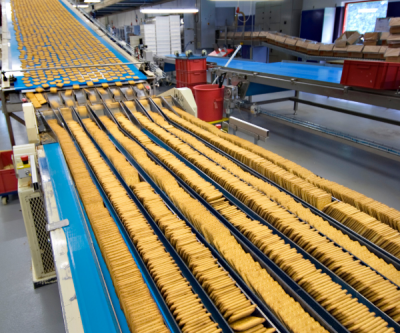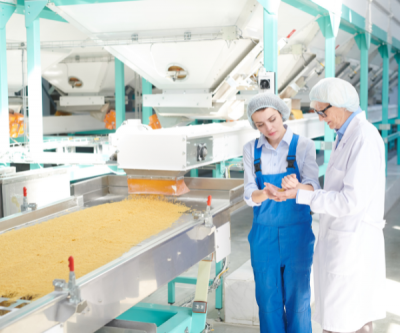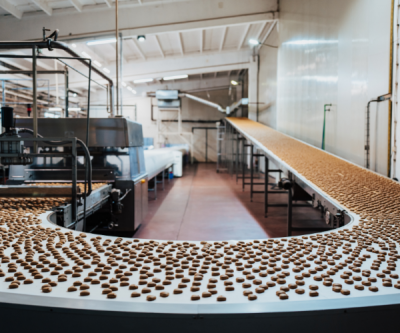Easy Clean Magnetic Grid (Grate) Separator
Removes ferrous particles from powders and granulates
 In the realm of food safety, the Hazard Analysis and Critical Control Points (HACCP) system stands as a cornerstone, providing a structured approach to identifying and managing potential hazards throughout the food production process. Central to the effectiveness of the HACCP system are Critical Control Points (CCPs) – pivotal junctures in the production line where controls can be applied to prevent, eliminate, or mitigate hazards to ensure the safety of the final product.
In the realm of food safety, the Hazard Analysis and Critical Control Points (HACCP) system stands as a cornerstone, providing a structured approach to identifying and managing potential hazards throughout the food production process. Central to the effectiveness of the HACCP system are Critical Control Points (CCPs) – pivotal junctures in the production line where controls can be applied to prevent, eliminate, or mitigate hazards to ensure the safety of the final product.
In food processing, the ability to accurately identify and strategically locate CCPs within operations is paramount. This article delves into the fundamental aspects of CCPs, shedding light on their significance and the methodologies involved in their identification and placement within food processing facilities.
We will also explore the invaluable role that innovative technologies such as magnetic separation and metal detection systems play in fortifying the HACCP framework. These systems provide advanced means to detect and eliminate metal contaminants, a common hazard in food processing, safeguarding the integrity and safety of the food supply chain.
Discover our range of magnetic separation and metal detection systems
Critical Control Points (CCPs) are pivotal stages in the food production process where controls can be applied to prevent, eliminate, or reduce hazards to acceptable levels. Within the framework of the Hazard Analysis and Critical Control Points (HACCP) system, CCPs serve as the focal points for ensuring food safety from raw material sourcing to the final product's distribution.
At these critical junctures, specific measures are implemented to address identified hazards effectively. These hazards can encompass biological, chemical, or physical contaminants that pose risks to consumers if not managed properly. By pinpointing CCPs, food processors can implement targeted interventions to mitigate these risks and uphold stringent safety standards.
CCPs are determined through a rigorous analysis of the entire production process, typically following a seven-step HACCP plan. This process involves:
Examples of common CCPs in food processing include cooking temperatures, pH levels, and time-temperature controls during cooling and storage. By accurately identifying and managing CCPs, food processors can mitigate risks, enhance product safety, and ensure compliance with regulatory standards.
 Locating critical control points (CCPs) within a food processing facility is a fundamental step in ensuring the safety and quality of the food products. CCPs are specific stages in the production process where controls can be applied to prevent, eliminate, or reduce food safety hazards to acceptable levels. Identifying and strategically placing these points is crucial for effective hazard management.
Locating critical control points (CCPs) within a food processing facility is a fundamental step in ensuring the safety and quality of the food products. CCPs are specific stages in the production process where controls can be applied to prevent, eliminate, or reduce food safety hazards to acceptable levels. Identifying and strategically placing these points is crucial for effective hazard management.
The process of locating CCPs begins with a comprehensive hazard analysis. This involves identifying potential biological, chemical, and physical hazards that could pose risks at various stages of the food production process. A thorough understanding of the entire production workflow, from raw material receipt to final product distribution, is essential for pinpointing where hazards are likely to occur.
Each step in the food production process must be evaluated for its potential to introduce or exacerbate hazards. This evaluation should consider factors such as the nature of the ingredients, processing methods, equipment used, and environmental conditions. Steps that are particularly vulnerable to contamination or where the introduction of hazards is most likely should be scrutinised closely.
For example, placing a magnetic separation system before a screw conveyor can help to prevent the damage of the screw conveyor from any metal contamination. However, a further separation system should then be placed after the screw conveyor, to protect the product from any contamination caused by wear on the screw conveyor.
A CCP is identified by determining which steps in the process have a significant impact on the control of hazards. To do this, food processors can utilise decision-making tools like the CCP decision tree. This tool helps determine whether a step is a CCP by asking a series of questions about the potential hazard and the feasibility of control measures at that step. If a hazard can be prevented, eliminated, or reduced to an acceptable level at a specific step, then that step is designated as a CCP.
Once identified, CCPs must be strategically placed within the production line to maximise their effectiveness. This placement involves ensuring that controls are implemented at points where they will have the greatest impact on hazard reduction. For instance, cooking and pasteurisation stages are common CCPs because they can eliminate biological hazards. Similarly, filtering steps may be CCPs for removing physical contaminants.
Magnetic separation and metal detection systems are critical technologies in managing CCPs, particularly for physical hazards like metal contamination. These systems should be placed at strategic points where the risk of metal contamination is highest. Common locations include:
 Magnetic separation and metal detection systems play a vital role in the effective management of metal contaminants, providing robust solutions to identify and eliminate these hazards from the production line. Here’s a detailed look at how these systems operate and their importance in the food processing environment.
Magnetic separation and metal detection systems play a vital role in the effective management of metal contaminants, providing robust solutions to identify and eliminate these hazards from the production line. Here’s a detailed look at how these systems operate and their importance in the food processing environment.
Metal contaminants can enter the food production process at various stages, from raw material handling to processing and packaging. These contaminants pose significant risks to consumer safety, potentially causing injury or health issues.
Additionally, metal contamination can lead to costly recalls, brand damage, and regulatory penalties. Implementing magnetic separation and metal detection systems is essential to prevent these risks and ensure the safety and integrity of food products.
Magnetic separation systems use strong magnets to attract and capture ferrous metals from the production flow. These systems are especially effective in removing small metal particles that might be missed by other types of filters.
Magnetic separators are typically installed at strategic points where metal contamination is most likely to occur, such as:
The benefits of using magnetic separation and metal detection systems are numerous, including:
Discover our range of magnetic separation and metal detection systems
 Effective integration of magnetic separation and metal detection systems into HACCP plans is essential for ensuring food safety and maintaining high-quality standards. These systems play a crucial role in identifying and eliminating metal contaminants, thereby preventing potential health hazards and protecting processing equipment.
Effective integration of magnetic separation and metal detection systems into HACCP plans is essential for ensuring food safety and maintaining high-quality standards. These systems play a crucial role in identifying and eliminating metal contaminants, thereby preventing potential health hazards and protecting processing equipment.
In this section, we outline strategies for the integration of magnetic separation and metal detection systems into your HACCP plans.
Magnetic Separators: Placed at raw material intake points to remove large ferrous contaminants (aka tramp materials) from bulk ingredients.
Metal Detectors and Separators: Used to scan incoming raw materials for metal particles before they enter the main processing area.
In-Line Magnetic Filters: Positioned before and after critical equipment such as grinders, mixers, and slicers to protect machinery and remove contaminants from semi-processed food. Machinery wear can cause new contamination, so it’s essential to detect and remove this from the production line.
Integrated Metal Detection Systems: Installed at mid-process points where product consistency allows for effective detection and removal of metal contaminants.
Metal Detectors: Placed at the end of the production line to ensure that the finished product is free from metal contaminants before packaging and shipment.
Combination Systems: Using both magnetic separation and metal detection at final inspection points for layered protection.
Implementing HACCP and effectively identifying and managing critical control points (CCPs) are essential steps in ensuring food safety and quality in food processing. By conducting thorough hazard analyses and strategically integrating advanced technologies such as magnetic separation and metal detection systems, food processors can significantly reduce the risk of contamination. These measures not only protect consumers but also enhance operational efficiency and compliance with regulatory standards.
Eclipse Magnetics provides robust solutions which seamlessly integrate into HACCP plans, demonstrating proven success in safeguarding food products. As the food industry continues to evolve, maintaining a proactive approach to food safety will remain paramount, ensuring that high standards are consistently met and upheld.
To discuss your application requirements and receive personalised advice, contact our sales team today.